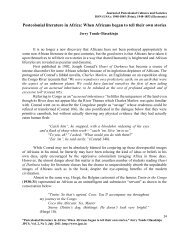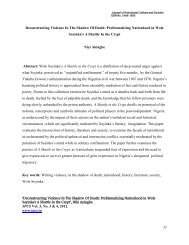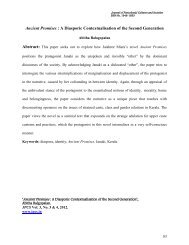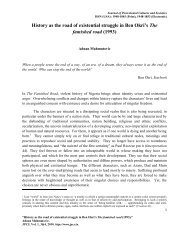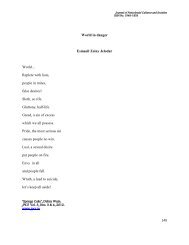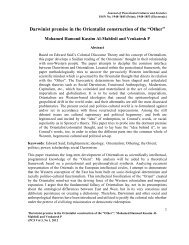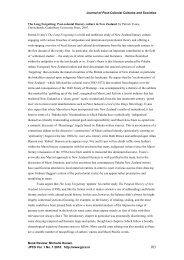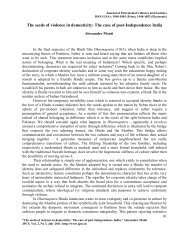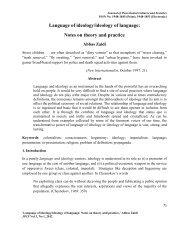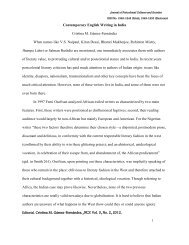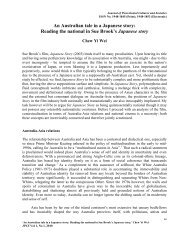'Crossing Thresholds': Radical Notes in Women's Writings ... - JPCS
'Crossing Thresholds': Radical Notes in Women's Writings ... - JPCS
'Crossing Thresholds': Radical Notes in Women's Writings ... - JPCS
You also want an ePaper? Increase the reach of your titles
YUMPU automatically turns print PDFs into web optimized ePapers that Google loves.
Journal of Postcolonial Cultures and SocietiesISSN No. 1948-1845 (Pr<strong>in</strong>t); 1948-1853 (Electronic)attempts to extend this evocative and emotive notion of threshold cross<strong>in</strong>g by <strong>in</strong>terpret<strong>in</strong>gand equat<strong>in</strong>g it witha. transgression, subversion or devianceb. assertion of women‘s agency for social change andc. freedom from social , economic and political ‗unfreedoms‘(Sen 2000)The writ<strong>in</strong>gs of South Asian women, despite a heavy hand of official and unofficialcensorship, reveal an <strong>in</strong>tricate <strong>in</strong>terweav<strong>in</strong>g of the political and the personal. By‗personal‘ I mean ,what Chandra Talpade Mohanty ma<strong>in</strong>ta<strong>in</strong>s, not someth<strong>in</strong>g ―as‗immediate feel<strong>in</strong>gs expressed confessionally‘ but as someth<strong>in</strong>g that is deeply historicaland collective -- as determ<strong>in</strong>ed by our <strong>in</strong>volvement <strong>in</strong> collectivities and communities andthrough political engagements‖ (Mohanty 2003: 191). These acts of defiance, bothorganized and anonymous, serve as powerful tools of political/personal <strong>in</strong>tervention.Literature can act as a radical tool for op<strong>in</strong>ion formation, provid<strong>in</strong>g deep, mean<strong>in</strong>gfulunderstand<strong>in</strong>g of the problems, conflicts and struggles of South Asian societies. Manyscholars and authors have focused on South Asia but not much attempt has been made tosee the contemporary South Asia through women‘s eye. The fem<strong>in</strong>ist vision of socialtransformation and change has been observed <strong>in</strong> the textual creativity and <strong>in</strong> the writ<strong>in</strong>gpractices of women writers of South Asia.This fem<strong>in</strong>ist practice of ‗look<strong>in</strong>g at‘ the worldcritically and creatively stems from a deeply collective nature of fem<strong>in</strong>ist thought andalso by the fact that ‗be<strong>in</strong>g a woman has political consequences <strong>in</strong> the world we live <strong>in</strong>(Mohanty 2003:3). Recent years have seen women writers from this region far bettervisibility <strong>in</strong> literary doma<strong>in</strong> with the open<strong>in</strong>g up of Indian offices by foreign publisherslike Pengu<strong>in</strong> and Harper Coll<strong>in</strong>s which gave them opportunity and a platform to expressthemselves . With the Booker Prize to Arundhati Roy for The God of Small Th<strong>in</strong>gs, theOnassis International Competition Prize to Manjula Padmanabhan for Harvest and thePulitzer Prize to Jhumpa Lahiri for Interpreter of Maladies, women writers' creativity hasreceived <strong>in</strong>ternational recognition.‘Cross<strong>in</strong>g thresholds: <strong>Radical</strong> notes <strong>in</strong> women’s writ<strong>in</strong>gs from contemporary South Asia,’Madhu S<strong>in</strong>gh<strong>JPCS</strong> Vol 2 No 4, December 201181



